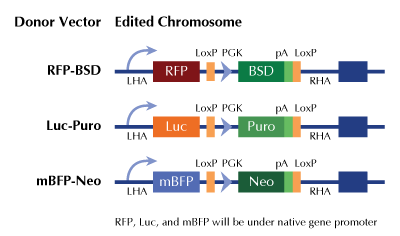PLAUR Human Gene Knockout Kit (CRISPR)
CAT#: KN201222BN
PLAUR - human gene knockout kit via CRISPR, HDR mediated
HDR-mediated knockout kit validation
CNY 12,260.00
CNY 3,710.00
CNY 3,656.00
CNY 3,990.00
Specifications
| Product Data | |
| Format | 2 gRNA vectors, 1 mBFP-Neo donor, 1 scramble control |
| Donor DNA | mBFP-Neo |
| Symbol | PLAUR |
| Locus ID | 5329 |
| Kit Components |
KN201222G1, PLAUR gRNA vector 1 in pCas-Guide CRISPR vector KN201222G2, PLAUR gRNA vector 2 in pCas-Guide CRISPR vector KN201222BN-D, donor DNA containing left and right homologous arms and mBFP-Neo functional cassette. GE100003, scramble sequence in pCas-Guide vector |
| Disclaimer | These products are manufactured and supplied by OriGene under license from ERS. The kit is designed based on the best knowledge of CRISPR technology. The system has been functionally validated for knocking-in the cassette downstream the native promoter. The efficiency of the knock-out varies due to the nature of the biology and the complexity of the experimental process. |
| Reference Data | |
| RefSeq | NM_001005376, NM_001005377, NM_001301037, NM_002659 |
| Synonyms | CD87; U-PAR; UPAR; URKR |
| Summary | This gene encodes the receptor for urokinase plasminogen activator and, given its role in localizing and promoting plasmin formation, likely influences many normal and pathological processes related to cell-surface plasminogen activation and localized degradation of the extracellular matrix. It binds both the proprotein and mature forms of urokinase plasminogen activator and permits the activation of the receptor-bound pro-enzyme by plasmin. The protein lacks transmembrane or cytoplasmic domains and may be anchored to the plasma membrane by a glycosyl-phosphatidylinositol (GPI) moiety following cleavage of the nascent polypeptide near its carboxy-terminus. However, a soluble protein is also produced in some cell types. Alternative splicing results in multiple transcript variants encoding different isoforms. The proprotein experiences several post-translational cleavage reactions that have not yet been fully defined. [provided by RefSeq, Jul 2008] |
Documents
| Product Manuals |
| FAQs |
Resources
| 基因表达相关资源 |
Other Versions
| SKU | Description | Size | Price |
|---|---|---|---|
| KN201222 | PLAUR - human gene knockout kit via CRISPR, HDR mediated |
CNY 12,260.00 |
|
| KN201222LP | PLAUR - human gene knockout kit via CRISPR, HDR mediated |
CNY 12,260.00 |
|
| KN201222RB | PLAUR - human gene knockout kit via CRISPR, HDR mediated |
CNY 12,260.00 |
|
| KN401222 | PLAUR - KN2.0, Human gene knockout kit via CRISPR, non-homology mediated. |
CNY 8,680.00 |
|
| GA103589 | PLAUR CRISPRa kit - CRISPR gene activation of human plasminogen activator, urokinase receptor |
CNY 12,255.00 |


 United States
United States
 Germany
Germany
 Japan
Japan
 United Kingdom
United Kingdom
 China
China

